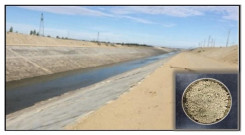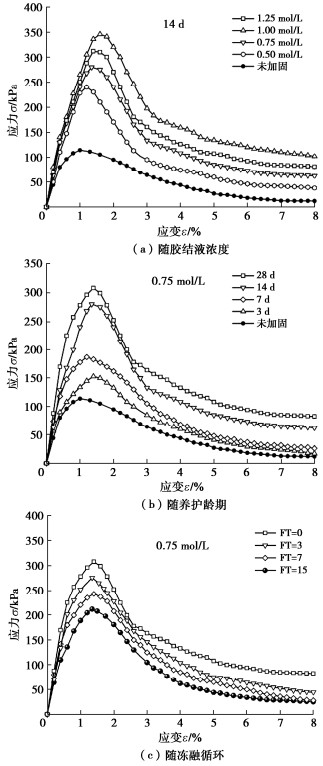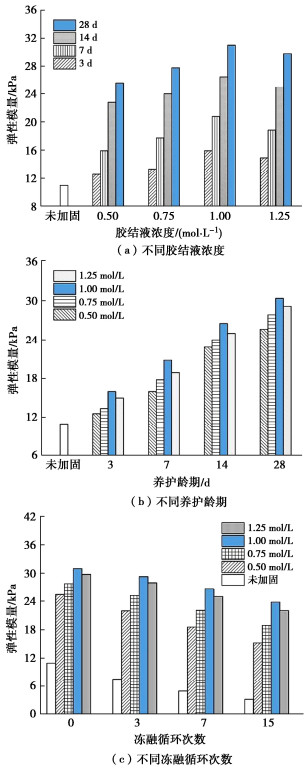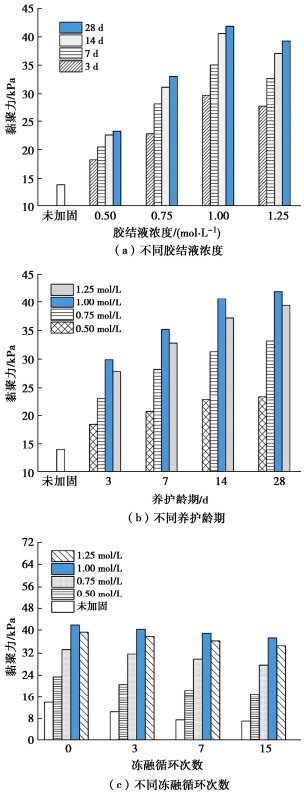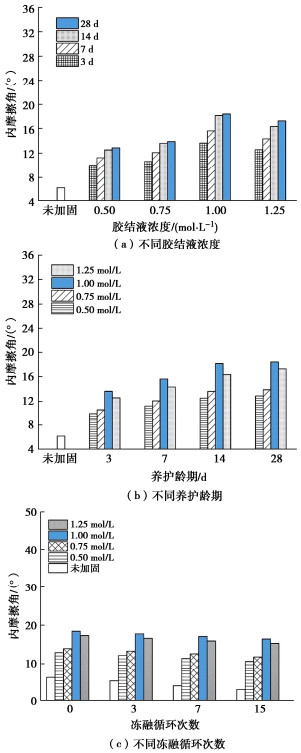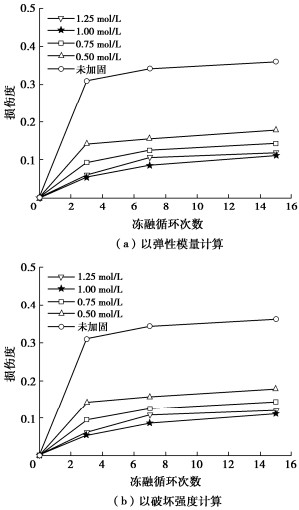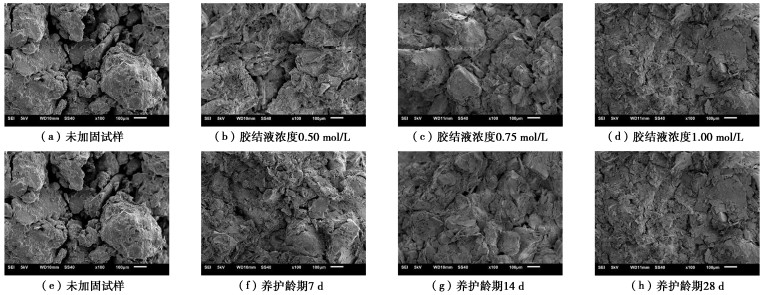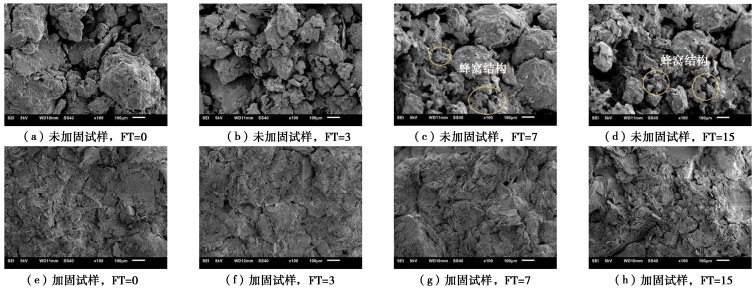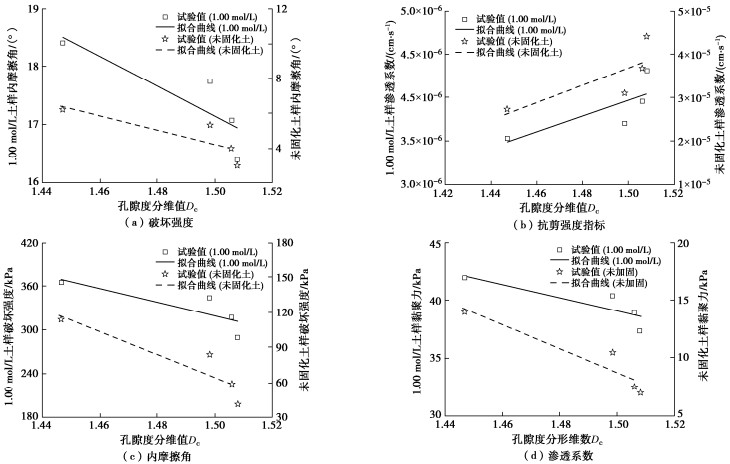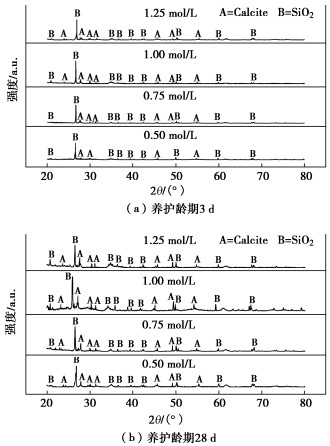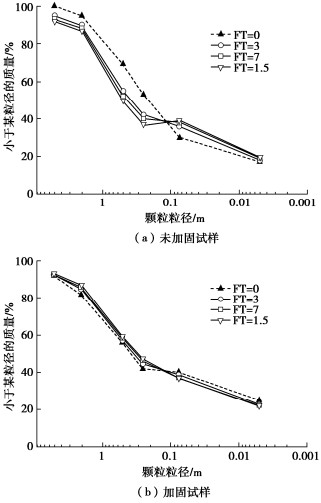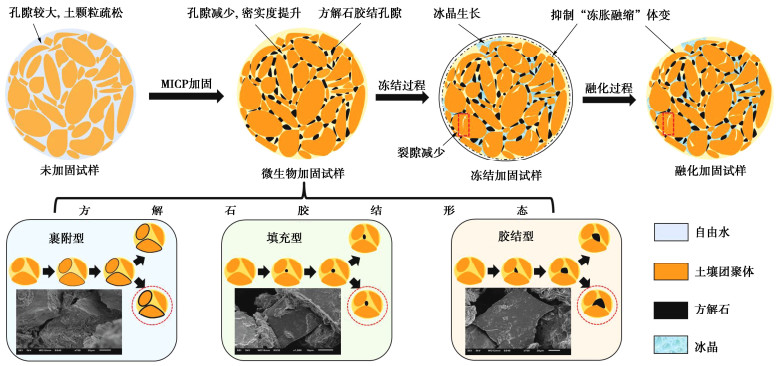Freeze-thaw performance and micro-mechanism of canal foundation silt treated by MICP
-
摘要: 渠基土性能冻融劣化是中国季冻区渠道结构损坏的主要原因,渠基土加固是保障供水渠道安全运行的重要手段。结合微生物岩土加固技术,开展微生物加固渠基粉土系列宏微观室内试验,刻画不同胶结液浓度、养护龄期、冻融循环下加固渠基粉土的体变率、渗透系数、孔隙率等宏微观指标的发展规律及其定量联系。结果表明:在不同胶结液浓度、养护龄期下,微生物加固可使得渠基粉土的冻融体变量削减约70%,渗透系数至少降低一个数量级、抗压强度提升约220.17%,抗剪强度指标最高增长约65.50%;当胶结液浓度为1.00 mol/L,养护龄期为28 d时,冻融循环下渠基粉土的微生物加固效果最优。此外,微生物诱导生成的碳酸钙沉淀通过填充、胶结、包裹等系列方式重塑了渠基粉土的微细观结构,使其在冻融风化作用下仍然保持整体性和完整性,这是微生物加固渠基粉土在冻融环境下仍然展现出良好工程特性的主要原因。
-
关键词:
- 微生物诱导碳酸钙沉淀 /
- 粉土 /
- 渠道边坡 /
- 冻融循环 /
- 微观结构
Abstract: The freeze-thaw deterioration characteristics of foundation soil are the main cause for damages of canal slopes in seasonally frozen areas. The soil treatment is an important means to ensure the safe operation of canals. Based on the microbially induced calcium carbonate precipitation (MICP) technique, a series of laboratory tests on treated silt with different concentrations, curing ages and freeze-thaw cycles are conducted. The macro-and micro-indices of treated silt, such as volumetric rate, permeability coefficient and porosity, are described, and their quantitative relationships are established. The results show that under different concentrations and curing ages, the treatment can reduce the freeze-thaw deformation by 70%, decrease the permeability coefficient by at least one order of magnitude, increase the compressive strength by 220.17%, and improve the shear strength index by 65.50%. As the concentration is 1.00 mol/L and the curing age is 28 days, the treatment effects of silt under freeze-thaw cycles are the most significant. In addition, the calcium carbonate precipitation induced by the MICP reshapes the microstructure of silt through a series of processes such as filling, cementation and encapsulation, which ensures the integrity of silt subjected to freeze-thaw cycles. It is also the main reason for the good engineering properties of treated silt in freeze-thaw environments.-
Keywords:
- MICP /
- silt /
- canal slope /
- freeze-thaw /
- micro-structure
-
0. 引言
随着中国交通行业的不断发展,中国桥梁建设水平得到大幅提升,对桥梁跨越能力的要求也不断增长,悬索桥作为所有桥型中跨越能力最大的桥型,越来越成为跨越大江、大河的主要解决方案。但是随着悬索桥跨度的不断增加,锚碇规模急剧扩大,造成锚碇建设成本过高。因此研究锚碇沉井基础的受力变形特性对于悬索桥的锚碇优化设计显得尤为重要。
Alampalli[1]在1994年研究了沉井在承受竖向和水平向荷载时的结构响应;李永盛[2]和李家平等[3]分别在1995年和2005年通过模型试验探讨了沉井基础的变形机制和破坏失稳形式;穆保岗等[4]在2017年通过模型试验研究了水平荷载长期作用下沉井变位的特性;Liu等[5]在2019年通过模型试验结合数值模拟分析研究了重力式锚碇的稳定性。
本文首先进行了在分级水平荷载下的沉井在砂箱中的模型试验,然后基于PLAXIS 3D软件建立了有限元模型,并分析了沉井的位移及沉井前侧和沉井底部的土压力,研究了水平荷载条件下沉井的受力变形规律。
1. 依托工程及模型试验
本文依托南京仙新路大桥北锚碇沉井工程,沉井长度为70 m,宽度为50 m,高度为49.5 m。该工程地基土以粉砂和中砂为主。
本试验采用的模型槽平面尺寸为4.0 m×2.0 m,高1.0 m。地基土采用中砂,其相对密度为2.68,最大孔隙比0.881,最小孔隙比0.463,不均匀系数3.89,曲率系数0.92。模型试验分层填筑地基土,控制每层填土的厚度为0.1 m,最终得到地基土的干密度为1.55 g/cm3,含水率0.63%,相对密实度为59.61%,内摩擦角为34.5°(快剪)。
沉井模型平面尺寸为0.7 m×0.5 m,高0.495 m,由厚度为22 mm的钢板焊接而成,试验过程将沉井看成刚体,不考虑沉井自身的变形,为模拟沉井与土体相互作用的界面,通过在沉井表面黏2~3 mm的砂粒实现[6],如图1所示。
模型试验中设计荷载为62kg,本文中水平荷载分级施加,每级荷载为设计荷载的~0.5倍,试验过程中每级荷载施加持续15 min直至土体破坏(土体破坏表现为沉井盖板处的位移急剧增大),沉井加载示意图如图2所示。
2. 有限元分析
本研究建立的有限元模型完全基于模型试验,土体及沉井的单元形状均为四面体十节点实体单元,数值模型的网格如图3所示。
砂土的本构模型采用土体硬化(HS)模型,土层参数[7]取值见表1。
表 1 土层参数Table 1. Soil parameters土层 γ /(kN·m-3)e Es /MPaErefoed /MPaEref50 /MPaErefur /MPac′ φ′ /(°)ψ /(°)m 砂土 15.6 0.723 10.2 10.2 10.2 30.6 0 34.5 0 0.5 注: γ 为砂土的重度;e 为砂土的孔隙比;Es 为砂土的压缩模量;Erefoed 为砂土的主固结加载切线刚度;Eref50 为砂土的标准三轴排水试验割线刚度;Erefur 为砂土的卸载重加载刚度;c′ 为砂土的有效黏聚力;φ′ 为砂土的有效摩擦角;ψ 为砂土的膨胀角;m 为砂土的刚度应力水平相关幂值。3. 试验结果与有限元结果对比
3.1 沉井顶部位移
在沉井盖板顶部设置3个位移测量点A、B、C。在位移测量点上放置位移靶标,采用TH-ISM-ST机器视觉测量仪对靶标位移进行测量,分辨率为0.01 mm,靶标布置如图4。
模型试验和数值模拟的位移对比如图5所示,由图易知,模型试验和数值模拟的靶标位移较为一致,本文中取水平位移随设计荷载增加而不断增加的线弹性阶段为水平承载力极限值[4],即安全系数取值为4。
3.2 沉井前侧壁土压力随施加荷载变化
在沉井前侧设置8个土压力盒,布置如图6所示,由于土压力盒对称分布,且沉井左右侧完全对称,因此取沉井左右两侧土压力盒平均值作为最终结果,结果如图7所示,其中模型试验中3号及3'号土压力盒数据较差,本文中已舍弃,余下的沉井前侧土压力盒数据和数值模拟结果较吻合。
3.3 沉井前侧壁土压力随施加荷载变化
在沉井底部设置12个土压力盒,布置如图8所示,同理,取沉井左右两侧土压力盒平均值作为最终结果,结果如图9所示,其中8号及8'号土压力盒数据较差,本文中已舍弃,余下的沉井底部土压力盒数据和数值模拟结果对比,发现当施加荷载/设计荷载的值小于等于4时较一致,当其值大于4之后,二者的结果相差较大。
4. 结论
本文在已有的研究基础上,通过开展模型试验和数值模拟计算,得到水平荷载下沉井的受力变位特性,主要得出以下结论:
(1)对锚碇沉井基础在砂土中的受力变位特性进行了试验研究和有限元分析,结果显示,水平荷载下锚碇沉井基础在砂土中的破坏模式为倾覆破坏,且安全系数远大于2,说明现阶段规范[8]中锚碇设计较为保守,有进一步的优化空间。
(2)通过PLAXIS 3D软件建立了锚碇沉井基础的有限元模型,采用应变硬化的本构模型,结果表明模型试验的结果和有限元模型计算的结果较为一致,说明数值建模过程中的土体本构模型及参数取值可靠,表明PLAXIS 3D软件能够较好的模拟锚碇沉井在砂土中的受力变形行为。
上述模型试验和有限元分析,只是针对水平荷载条件下锚碇沉井基础在砂土中的受力特性开展的研究,只考虑了单层干砂的地基土层,尚需更近一步探索。
-
表 1 试验土料的基本参数
Table 1 Fundamental properties of soil materials
相对质量密度 最大干密度/
(g·cm-3)最优含水率/% 液限/
%塑限/
%塑性
指数2.67 1.86 14.2 38.0 19.3 18.7 表 2 培养基具体成分与用量
Table 2 Specific ingredients and dosages of culture medium
成分 用量 蛋白胨 10 g/L 牛肉浸粉 3 g/L NaCl 5 g/L 去离子水 1000 ml pH 8.0~9.0(NAOH溶液) 注:细菌培养过程中,必要时可加入2%溶液体积的尿素或10 mg/L MnSO4.H2O可促进产胞。 表 3 试验方案
Table 3 Test scheme
工况 胶结液浓度/(mol·L-1) 养护龄期/d 冻融循环次数 未加固 — — 0, 3, 7, 15 加固 0.5, 0.75, 1.0, 1.25 0, 3, 7, 14, 28 0, 3, 7, 15 -
[1] 蔡正银, 朱锐, 黄英豪, 等. 冻融过程对膨胀土渠道边坡劣化模式的影响[J]. 水利学报, 2020, 51(8): 915-923. CAI Zhengyin, ZHU Rui, HUANG Yinghao, et al. Influences of freeze-thaw process on the deterioration mode of expansive soil canal slope[J]. Journal of Hydraulic Engineering, 2020, 51(8): 915-923. (in Chinese)
[2] 邢玮, 朱锐, 张晨, 等. 高寒地区供水渠道水热特征及其长期演化规律[J]. 南京工业大学学报(自然科学版), 2024, 46(1): 93-102. doi: 10.3969/j.issn.1671-7627.2024.01.011 XING Wei, ZHU Rui, ZHANG Chen, et al. Hydrothermal characteristics and its long-term evolution of canals in cold regions[J]. Journal of Nanjing Tech University (Natural Science Edition), 2024, 46(1): 93-102. (in Chinese) doi: 10.3969/j.issn.1671-7627.2024.01.011
[3] 汪恩良, 姜海强, 付强, 等. 冻融对饱和渠基土物理力学性质的影响[J]. 农业机械学报, 2018, 49(3): 287-294. WANG Enliang, JIANG Haiqiang, FU Qiang, et al. Experiment on effect of freezing and thawing on physical and mechanical properties of saturated channel foundation soil[J]. Transactions of the Chinese Society for Agricultural Machinery, 2018, 49(3): 287-294. (in Chinese)
[4] 黄英豪, 陈永, 朱洵, 等. 相变材料改良膨胀土冻融性能试验研究及微观机理分析[J]. 岩土工程学报, 2021, 43(11): 1994-2002. doi: 10.11779/CJGE202111005 HUANG Yinghao, CHEN Yong, ZHU Xun, et al. Experimental study and micro-mechanism analysis of freeze-thaw performance of expansive soils improved by phase-change materials[J]. Chinese Journal of Geotechnical Engineering, 2021, 43(11): 1994-2002. (in Chinese) doi: 10.11779/CJGE202111005
[5] 何稼, 楚剑, 刘汉龙, 等. 微生物岩土技术的研究进展[J]. 岩土工程学报, 2016, 38(4): 643-653. doi: 10.11779/CJGE201604008 HE Jia, CHU Jian, LIU Hanlong, et al. Research advances in biogeotechnologies[J]. Chinese Journal of Geotechnical Engineering, 2016, 38(4): 643-653. (in Chinese) doi: 10.11779/CJGE201604008
[6] 刘汉龙, 肖杨. 微生物土力学原理与应用[M]. 北京: 科学出版社, 2022. LIU Hanlong, XIAO Yang. Biocemented Soils Mechanical Principles and Applications[M]. Beijing: Science Press, 2022. (in Chinese)
[7] TANG C S, YIN L Y, JIANG N J, et al. Factors affecting the performance of microbial-induced carbonate precipitation (MICP) treated soil: a review[J]. Environmental Earth Sciences, 2020, 79(5): 94. doi: 10.1007/s12665-020-8840-9
[8] 邵光辉, 侯敏, 刘鹏. MICP固化粉土细菌的分布和固定规律研究[J]. 林业工程学报, 2019, 4(1): 128-134. SHAO Guanghui, HOU Min, LIU Peng. Distribution and fixation characteristics of microorganism in MICP treated silt column[J]. Journal of Forestry Engineering, 2019, 4(1): 128-134. (in Chinese)
[9] 刘璐, 沈扬, 刘汉龙, 等. 微生物胶结在防治堤坝破坏中的应用研究[J]. 岩土力学, 2016, 37(12): 3410-3416. LIU Lu, SHEN Yang, LIU Hanlong, et al. Application of bio-cement in erosion control of levees[J]. Rock and Soil Mechanics, 2016, 37(12): 3410-3416. (in Chinese)
[10] GAO Y F, TANG X Y, CHU J, et al. Microbially induced calcite precipitation for seepage control in sandy soil[J]. Geomicrobiology Journal, 2019, 36(4): 366-375. doi: 10.1080/01490451.2018.1556750
[11] JIN G X, XU K, XU C S, et al. Cementation of shale soils by MICP technology and its damage characteristics due to freeze-thaw weathering processes[J]. Journal of Cold Regions Engineering, 2020, 34(4): 04020023. doi: 10.1061/(ASCE)CR.1943-5495.0000229
[12] AHENKORAH I, RAHMAN M M, KARIM M R, et al. Unconfined compressive strength of MICP and EICP treated sands subjected to cycles of wetting-drying, freezing-thawing and elevated temperature: Experimental and EPR modelling[J]. Journal of Rock Mechanics and Geotechnical Engineering, 2023, 15(5): 1226-1247. doi: 10.1016/j.jrmge.2022.08.007
[13] LIU L, LIU H L, STUEDLEIN A W, et al. Strength, stiffness, and microstructure characteristics of biocemented calcareous sand[J]. Canadian Geotechnical Journal, 2019, 56(10): 1502-1513. doi: 10.1139/cgj-2018-0007
[14] WHIFFIN V S, VAN PAASSEN L A, HARKES M P. Microbial carbonate precipitation as a soil improvement technique[J]. Geomicrobiology Journal, 2007, 24(5): 417-423. doi: 10.1080/01490450701436505
[15] OLIVEIRA P J V, FREITAS L D, CARMONA J P S F. Effect of soil type on the enzymatic calcium carbonate precipitation process used for soil improvement[J]. Journal of Materials in Civil Engineering, 2017, 29(4): 04016263. doi: 10.1061/(ASCE)MT.1943-5533.0001804
[16] 土工试验方法标准: GB/T 50123—2019[S]. 北京: 中国计划出版社, 2019. Standard for Geotechnical Testing Method: GB/T 50123—2019[S]. Beijing: China Planning Press, 2019. (in Chinese)
[17] ZHANG W C, JU Y, ZONG Y W, et al. In situ real-time study on dynamics of microbially induced calcium carbonate precipitation at a single-cell level[J]. Environmental Science & Technology, 2018, 52(16): 9266-9276.
[18] 郑郧, 马巍, 邴慧. 冻融循环对土结构性影响的试验研究及影响机制分析[J]. 岩土力学, 2015, 36(5): 1282-1287, 1294. ZHENG Yun, MA Wei, BING Hui. Impact of freezing and thawing cycles on structure of soils and its mechanism analysis by laboratory testing[J]. Rock and Soil Mechanics, 2015, 36(5): 1282-1287, 1294. (in Chinese)
-
其他相关附件




 下载:
下载:








